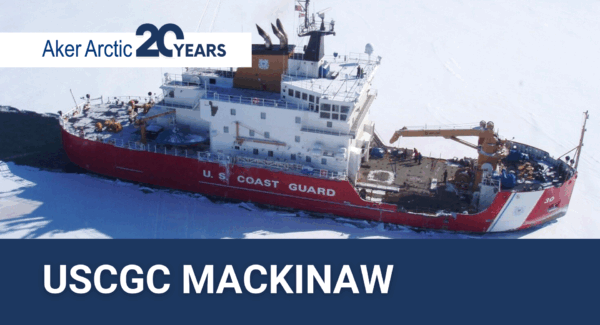Icebreaker fascination drew Aaron Tam to Finland
As an international company working with global clients, Aker Arctic continues to attract young professionals from all over the world eager to learn the art of icebreaker design. Five years ago, Aaron Tam joined the company, pursuing his dream of becoming a world-leading icebreaker designer.
Aaron Tam’s fascination with icebreakers began in his teenage years. Growing up in New York City, he found the sea and the icy frontiers of the polar regions to be unique, beautiful, and serene. In high school, during his engagement in speech and debate, he came in touch with icebreakers, which inspired him to pursue a bachelor’s degree in Naval Architecture and Marine Engineering at Webb Institute in Glen Cove, New York.

Long icebreaker history in Finland
Aaron’s interest in icebreakers deepened as he learned more about ship design. Realising that the icebreaking expertise was more advanced in Nordic countries, he decided to enrol in a Nordic Master’s programme in Cold Climate Engineering (Sea Track) to further his passions.
He studied one year at NTNU in Norway and another at Aalto University in Finland, expanding his knowledge in ice, the polar regions, and the engineering of ships and offshore structures in difficult winter conditions. He also gained firsthand experience in living in the harsh climate on Svalbard and being onboard an active icebreaker while in service.
In 2019, as he was wrapping up his master’s thesis researching icebreaking patterns and ice cusp formations at Aalto University in Finland, he applied to join Aker Arctic.
“I had known about Aker Arctic and its prestige in icebreaking ships. As I wanted to dedicate myself fully to icebreaker design, it felt like the perfect place for me,” Aaron shares.
Aligning a design with client expectations
Over the past five years at Aker Arctic, Aaron has worked primarily as a naval architect within the Ship Design Department. He initially worked on shorter term projects doing concept outlines, retrofitting, ice condition studies, transit analysis, and weight calculations before moving on to longer term projects.

“One of the first larger projects I was involved with was the design of the Multi-Purpose Vessel (MPV) Project for Canada,” Aaron says.
“My responsibilities included, not only general design and arrangement tasks, but also ship performance, seakeeping, manoeuvring, stability, and weights, with support from my expert colleagues. I was also interacting directly with the client to ensure their satisfaction with the final outcome,” he explains.
He found it particularly rewarding to develop a design from its early stages alongside the client, adjusting and shaping the design according to the client’s needs and expectations, through presenting different options and creating tailored solutions.
Turning a concept design into reality
Since then, Aaron, jointly with his team, has been tackling the work of progressing the design of the Polar Icebreaker project for the Canadian Coast Guard and Seaspan Shipyards. Aaron has been taking on the role of project coordination and technical discipline lead, integrating Aker Arctic’s capabilities into the design collaboration with the multiple companies involved in the Polar Icebreaker.

“As we have also assumed a technical authority role to ensure all details are done under good design principles and are in line with standards and regulations, I have recently been continuously double-checking everything, to confirm the design is going in the right direction,” Aaron adds.
The Polar Icebreaker coordination work has provided Aaron with hands-on experience in preparing a concept design for production.
“One of the key lessons I have learned is understanding from a practical standpoint what is possible and what is not, and how earlier decision inputs can create challenges later if they are not fully comprehended,” he emphasises.
Learning the steps in design work
Aaron’s future aspiration is to become a Chief Designer, where he can create an icebreaker from scratch. He feels that working at Aker Arctic is the ideal environment to learn, step by step, how to become a successful icebreaker designer.

“Aker Arctic houses many industry veterans and experts. Being able to work, collaborate, and exchange knowledge with such brilliant engineers has been vital in paving the path for my development. It is this highly capable and cooperative design team that I work alongside every day that creates the environment for successful icebreakers to be designed, and I am proud to be part of this team,” he says.
However, living in Helsinki means being far from his family in New York.
“Naturally, there are things I miss from home, especially the never-ending cultural activities and the variety of restaurants available in a city as big as New York. When visiting home, I go watch a Broadway show nearly every night, as I am a huge fan of musicals,” Aaron says.
“In Finland, I enjoy connecting with nature; walking in the forest, picking mushrooms and berries, and experiencing the changing seasons. I have always preferred the cold and love the winters here, especially when there is snow. Travelling to other European countries is also easy as a weekend getaway.”

Building friendships in new places
During his studies, Aaron moved frequently and discovered that having a social hobby is a great way to meet people and make friends in new places. Through his hobby of swing dancing, he has become part of a large community that regularly gathers for social dancing events and dance festivals, both in Finland and other European cities.
“Language-wise, I have not yet mastered Finnish properly, but since Aker Arctic is an international company and we work with global clients, using English at work has never been an issue,” Aaron notes.
He has recently purchased his own apartment in Helsinki and is adapting to the more relaxed pace of life in Finland, where closeness to nature plays a significant role.
“Overall, it feels very good to be in Finland and part of such a renowned company with a long history of designing, in my opinion, the most fascinating ships,” he concludes.
Text by Catarina Stewen

